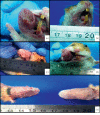DMBA-Induced Oral Carcinoma in Syrian Hamster: Increased Carcinogenic Effect by Dexamethasone Coexposition
- PMID: 32149076
- PMCID: PMC7042540
- DOI: 10.1155/2020/1470868
DMBA-Induced Oral Carcinoma in Syrian Hamster: Increased Carcinogenic Effect by Dexamethasone Coexposition
Abstract
Objectives: To investigate the effect of systemic administration of the immunosuppressant dexamethasone (DM) while inducing hamster buccal pouch DMBA carcinogenesis. Materials and Methods. Two different experiments were performed. In the first experiment, hamsters' right buccal pouches in group A (n = 10) were painted three times per week with 7,12-dimethylbenzanthracene (DMBA) 0.5%, while pouches of animals in group B (n = 10) were painted three times per week with 7,12-dimethylbenzanthracene (DMBA) 0.5%, while pouches of animals in group B (.
Results: The time of macroscopic neoplasm development was reduced when DM-DMBA coexposition was employed, finding tumors after 10-12 weeks of exposition. In addition, the frequency of histopathological lesions was higher.
Conclusion: Immunomodulatory action of dexamethasone may reduce the time of oral squamous cell carcinoma (OSCC) induction and may increase the incidence of neoplasms developed.
Copyright © 2020 Diana A. Martínez B. et al.
Conflict of interest statement
The authors declare that they have no conflicts of interest.
Figures




Similar articles
-
Coffee enhances the development of 7,12-dimethylbenz[a]anthracene (DMBA)-induced hamster buccal pouch carcinomas.Oral Oncol. 2001 Feb;37(2):172-6. doi: 10.1016/s1368-8375(00)00084-1. Oral Oncol. 2001. PMID: 11167145
-
Anti-tumour and anti-oxidative potential of diosgenin against 7, 12-dimethylbenz(a)anthracene induced experimental oral carcinogenesis.Pathol Oncol Res. 2012 Apr;18(2):405-12. doi: 10.1007/s12253-011-9460-1. Epub 2011 Oct 12. Pathol Oncol Res. 2012. PMID: 21990007
-
Cancer induction in the DMBA hamster cheek pouch: a modified technique using a promoter.Laryngoscope. 2001 Feb;111(2):204-6. doi: 10.1097/00005537-200102000-00003. Laryngoscope. 2001. PMID: 11210861
-
Chemopreventive potential of coumarin in 7, 12-dimethylbenz[a] anthracene induced hamster buccal pouch carcinogenesis.Asian Pac J Cancer Prev. 2012;13(10):5273-9. doi: 10.7314/apjcp.2012.13.10.5273. Asian Pac J Cancer Prev. 2012. PMID: 23244148
-
Effects of Spirulina platensis extract on Syrian hamster cheek pouch mucosa painted with 7,12-dimethylbenz[a]anthracene.Oral Oncol. 2008 Oct;44(10):956-62. doi: 10.1016/j.oraloncology.2007.11.014. Epub 2008 Feb 8. Oral Oncol. 2008. PMID: 18262461
Cited by
-
Development of a murine model of oral carcinogenesis: an accelerated tool for biomarker and anti-tumour drug discovery.Ecancermedicalscience. 2022 Jun 15;16:1413. doi: 10.3332/ecancer.2022.1413. eCollection 2022. Ecancermedicalscience. 2022. PMID: 36072235 Free PMC article.
References
-
- Wong D. T., Todd R., Shklar G., Rustgi A. Head Neck Cancer. Cambridge, MA, USA: Academic Press; 2003. Animal models in head and neck cancer; pp. 57–63.
MeSH terms
Substances
LinkOut - more resources
Full Text Sources
Medical

